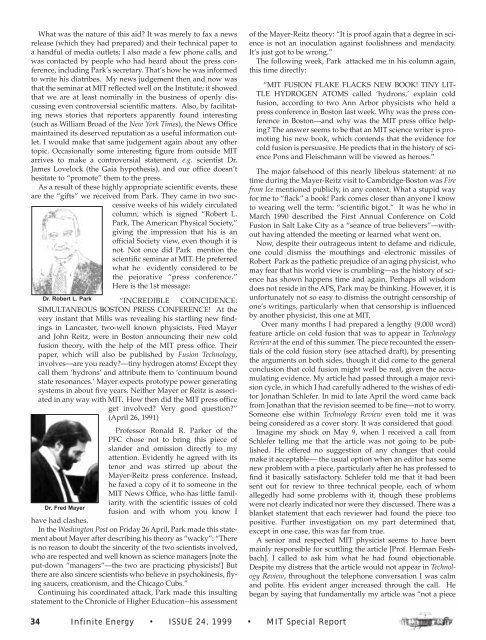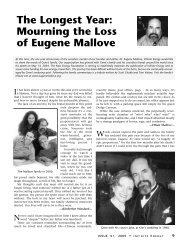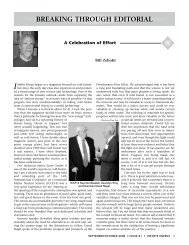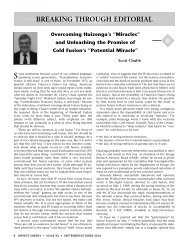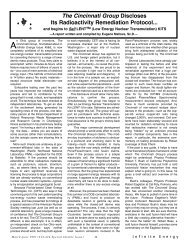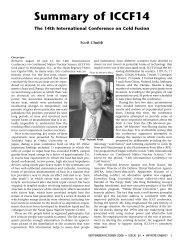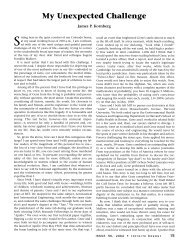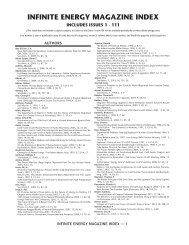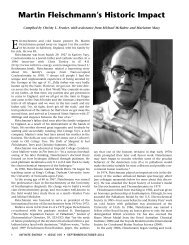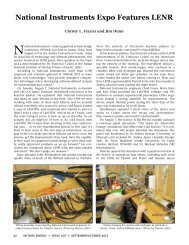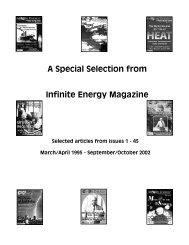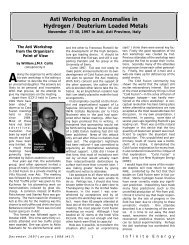MIT and Cold Fusion: A Special Report - Infinite Energy Magazine
MIT and Cold Fusion: A Special Report - Infinite Energy Magazine
MIT and Cold Fusion: A Special Report - Infinite Energy Magazine
Create successful ePaper yourself
Turn your PDF publications into a flip-book with our unique Google optimized e-Paper software.
What was the nature of this aid? It was merely to fax a news<br />
release (which they had prepared) <strong>and</strong> their technical paper to<br />
a h<strong>and</strong>ful of media outlets; I also made a few phone calls, <strong>and</strong><br />
was contacted by people who had heard about the press conference,<br />
including Park’s secretary. That’s how he was informed<br />
to write his diatribes. My news judgement then <strong>and</strong> now was<br />
that the seminar at <strong>MIT</strong> reflected well on the Institute; it showed<br />
that we are at least nominally in the business of openly discussing<br />
even controversial scientific matters. Also, by facilitating<br />
news stories that reporters apparently found interesting<br />
(such as William Broad of the New York Times), the News Office<br />
maintained its deserved reputation as a useful information outlet.<br />
I would make that same judgement again about any other<br />
topic. Occasionally some interesting figure from outside <strong>MIT</strong><br />
arrives to make a controversial statement, e.g. scientist Dr.<br />
James Lovelock (the Gaia hypothesis), <strong>and</strong> our office doesn’t<br />
hesitate to “promote” them to the press.<br />
As a result of these highly appropriate scientific events, these<br />
are the “gifts” we received from Park. They came in two successive<br />
weeks of his widely circulated<br />
column, which is signed “Robert L.<br />
Park, The American Physical Society,”<br />
giving the impression that his is an<br />
official Society view, even though it is<br />
not. Not once did Park mention the<br />
scientific seminar at <strong>MIT</strong>. He preferred<br />
what he evidently considered to be<br />
the pejorative “press conference.”<br />
Here is the 1st message:<br />
Dr. Robert L. Park “INCREDIBLE COINCIDENCE:<br />
SIMULTANEOUS BOSTON PRESS CONFERENCE! At the<br />
very instant that Mills was revealing his startling new findings<br />
in Lancaster, two-well known physicists, Fred Mayer<br />
<strong>and</strong> John Reitz, were in Boston announcing their new cold<br />
fusion theory, with the help of the <strong>MIT</strong> press office. Their<br />
paper, which will also be published by <strong>Fusion</strong> Technology,<br />
involves—are you ready?—tiny hydrogen atoms! Except they<br />
call them ‘hydrons’ <strong>and</strong> attribute them to ‘continuum bound<br />
state resonances.’ Mayer expects prototype power generating<br />
systems in about five years. Neither Mayer or Reitz is associated<br />
in any way with <strong>MIT</strong>. How then did the <strong>MIT</strong> press office<br />
get involved? Very good question?”<br />
(April 26, 1991)<br />
Professor Ronald R. Parker of the<br />
PFC chose not to bring this piece of<br />
sl<strong>and</strong>er <strong>and</strong> omission directly to my<br />
attention. Evidently he agreed with its<br />
tenor <strong>and</strong> was stirred up about the<br />
Mayer-Reitz press conference. Instead,<br />
he faxed a copy of it to someone in the<br />
<strong>MIT</strong> News Office, who has little familiarity<br />
with the scientific issues of cold<br />
Dr. Fred Mayer<br />
fusion <strong>and</strong> with whom you know I<br />
have had clashes.<br />
In the Washington Post on Friday 26 April, Park made this statement<br />
about Mayer after describing his theory as “wacky”: “There<br />
is no reason to doubt the sincerity of the two scientists involved,<br />
who are respected <strong>and</strong> well known as science managers [note the<br />
put-down “managers”—the two are practicing physicists!] But<br />
there are also sincere scientists who believe in psychokinesis, flying<br />
saucers, creationism, <strong>and</strong> the Chicago Cubs.”<br />
Continuing his coordinated attack, Park made this insulting<br />
statement to the Chronicle of Higher Education--his assessment<br />
of the Mayer-Reitz theory: “It is proof again that a degree in science<br />
is not an inoculation against foolishness <strong>and</strong> mendacity.<br />
It’s just got to be wrong.”<br />
The following week, Park attacked me in his column again,<br />
this time directly:<br />
“<strong>MIT</strong> FUSION FLAKE FLACKS NEW BOOK! TINY LIT-<br />
TLE HYDROGEN ATOMS called ‘hydrons,’ explain cold<br />
fusion, according to two Ann Arbor physicists who held a<br />
press conference in Boston last week. Why was the press conference<br />
in Boston—<strong>and</strong> why was the <strong>MIT</strong> press office helping?<br />
The answer seems to be that an <strong>MIT</strong> science writer is promoting<br />
his new book, which contends that the evidence for<br />
cold fusion is persuasive. He predicts that in the history of science<br />
Pons <strong>and</strong> Fleischmann will be viewed as heroes.”<br />
The major falsehood of this nearly libelous statement: at no<br />
time during the Mayer-Reitz visit to Cambridge-Boston was Fire<br />
from Ice mentioned publicly, in any context. What a stupid way<br />
for me to “flack” a book! Park comes closer than anyone I know<br />
to wearing well the term: “scientific bigot.” It was he who in<br />
March 1990 described the First Annual Conference on <strong>Cold</strong><br />
<strong>Fusion</strong> in Salt Lake City as a “seance of true believers”—without<br />
having attended the meeting or learned what went on.<br />
Now, despite their outrageous intent to defame <strong>and</strong> ridicule,<br />
one could dismiss the mouthings <strong>and</strong> electronic missiles of<br />
Robert Park as the pathetic prejudice of an aging physicist, who<br />
may fear that his world view is crumbling—as the history of science<br />
has shown happens time <strong>and</strong> again. Perhaps all wisdom<br />
does not reside in the APS, Park may be thinking. However, it is<br />
unfortunately not so easy to dismiss the outright censorship of<br />
one’s writings, particularly when that censorship is influenced<br />
by another physicist, this one at <strong>MIT</strong>.<br />
Over many months I had prepared a lengthy (9,000 word)<br />
feature article on cold fusion that was to appear in Technology<br />
Review at the end of this summer. The piece recounted the essentials<br />
of the cold fusion story (see attached draft), by presenting<br />
the arguments on both sides, though it did come to the general<br />
conclusion that cold fusion might well be real, given the accumulating<br />
evidence. My article had passed through a major revision<br />
cycle, in which I had carefully adhered to the wishes of editor<br />
Jonathan Schlefer. In mid to late April the word came back<br />
from Jonathan that the revision seemed to be fine—not to worry.<br />
Someone else within Technology Review even told me it was<br />
being considered as a cover story. It was considered that good.<br />
Imagine my shock on May 9, when I received a call from<br />
Schlefer telling me that the article was not going to be published.<br />
He offered no suggestion of any changes that could<br />
make it acceptable— the usual option when an editor has some<br />
new problem with a piece, particularly after he has professed to<br />
find it basically satisfactory. Schlefer told me that it had been<br />
sent out for review to three technical people, each of whom<br />
allegedly had some problems with it, though these problems<br />
were not clearly indicated nor were they discussed. There was a<br />
blanket statement that each reviewer had found the piece too<br />
positive. Further investigation on my part determined that,<br />
except in one case, this was far from true.<br />
A senior <strong>and</strong> respected <strong>MIT</strong> physicist seems to have been<br />
mainly responsible for scuttling the article [Prof. Herman Feshbach].<br />
I called to ask him what he had found objectionable.<br />
Despite my distress that the article would not appear in Technology<br />
Review, throughout the telephone conversation I was calm<br />
<strong>and</strong> polite. His evident anger increased through the call. He<br />
began by saying that fundamentally my article was “not a piece<br />
34 <strong>Infinite</strong> <strong>Energy</strong> • ISSUE 24, 1999 • <strong>MIT</strong> <strong>Special</strong> <strong>Report</strong>


